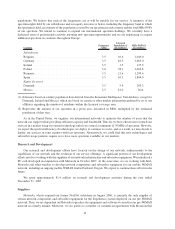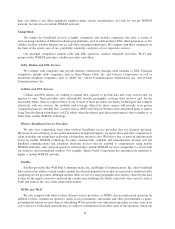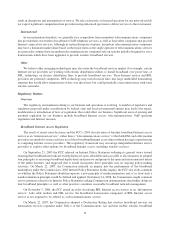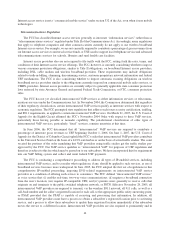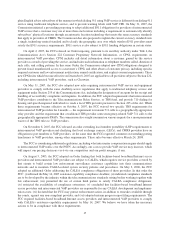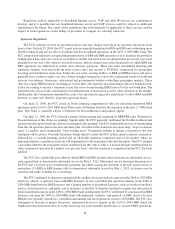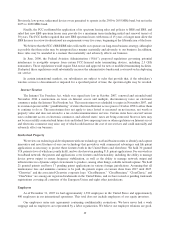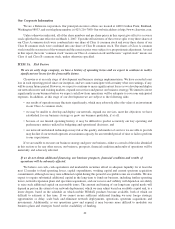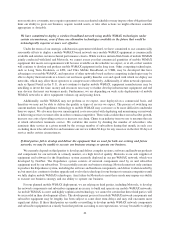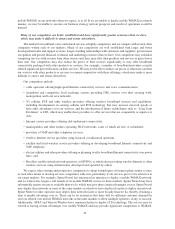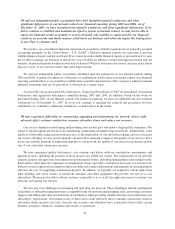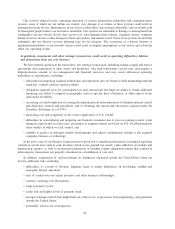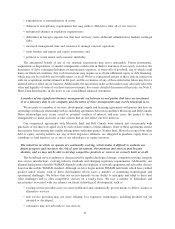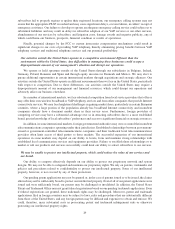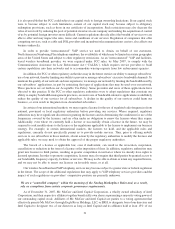Clearwire 2007 Annual Report Download - page 31
Download and view the complete annual report
Please find page 31 of the 2007 Clearwire annual report below. You can navigate through the pages in the report by either clicking on the pages listed below, or by using the keyword search tool below to find specific information within the annual report.mobile WiMAX on our networks when we expect, or at all. If we are unable to deploy mobile WiMAX in a timely
manner, we may be unable to execute our business strategy and our prospects and results of operations would be
harmed.
Many of our competitors are better established and have significantly greater resources than we have,
which may make it difficult to attract and retain subscribers.
The market for broadband, voice and related services is highly competitive, and we compete with several other
companies within each of our markets. Many of our competitors are well established with larger and better
developed networks and support systems, longer-standing relationships with customers and suppliers, greater name
recognition and greater financial, technical and marketing resources than we have. Our competitors may subsidize
competing services with revenue from other sources and, thus, may offer their products and services at prices lower
than ours. Our competitors may also reduce the prices of their services significantly or may offer broadband
connectivity packaged with other products or services. For example, a number of broadband providers recently
offered significant price reductions on their services. We may not be able to reduce our prices or otherwise combine
our services with other products or services to remain competitive with these offerings, which may make it more
difficult to attract and retain subscribers.
Our competitors include:
• cable operators offering high-speed Internet connectivity services and voice communications;
• incumbent and competitive local exchange carriers providing DSL services over their existing wide,
metropolitan and local area networks;
• 3G cellular, PCS and other wireless providers offering wireless broadband services and capabilities,
including developments in existing cellular and PCS technology that may increase network speeds or
have other advantages over our services, and the introduction of future technologies such as “Long Term
Evolution” or LTE, which may enable these providers to offer services that are comparable or superior to
ours;
• Internet service providers offering dial-up Internet connectivity;
• municipalities and other entities operating Wi-Fi networks, some of which are free or subsidized;
• providers of VoIP and other telephony services;
• wireless Internet service providers using licensed or unlicensed spectrum;
• satellite and fixed wireless service providers offering or developing broadband Internet connectivity and
VoIP telephony;
• electric utilities and other providers offering or planning to offer broadband Internet connectivity over power
lines; and
• Resellers, mobile virtual network operators, or MVNOs, or wholesalers providing wireless Internet or other
wireless services using infrastructure developed and operated by others.
We expect other existing and prospective competitors to adopt technologies or business plans similar to ours,
or seek other means to develop services competitive with ours, particularly if our services prove to be attractive in
our target markets. For example, Sprint Nextel has announced its intention to deploy a mobile WiMAX network,
and we believe has begun a soft launch of its mobile WiMAX service in three markets. Sprint Nextel may have
substantially greater resources available than we do, which may give them certain advantages over us. Sprint Nextel
may deploy their network in some of the same markets in which we have deployed or plan to deploy our network.
Sprint Nextel or other operators may deploy their network faster or more broadly than we do, thereby obtaining a
time to market advantage over us. There can be no assurances that there will be sufficient customer demand for
services offered over mobile WiMAX networks in the same markets to allow multiple operators, if any, to succeed.
Additionally, AT&T and Verizon Wireless have announced plans to deploy LTE technology. This service may be
viewed as having certain advantages over mobile WiMAX and may provide significant competition to WiMAX.
23


